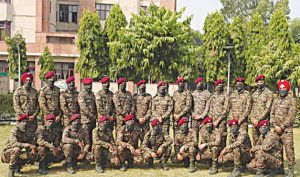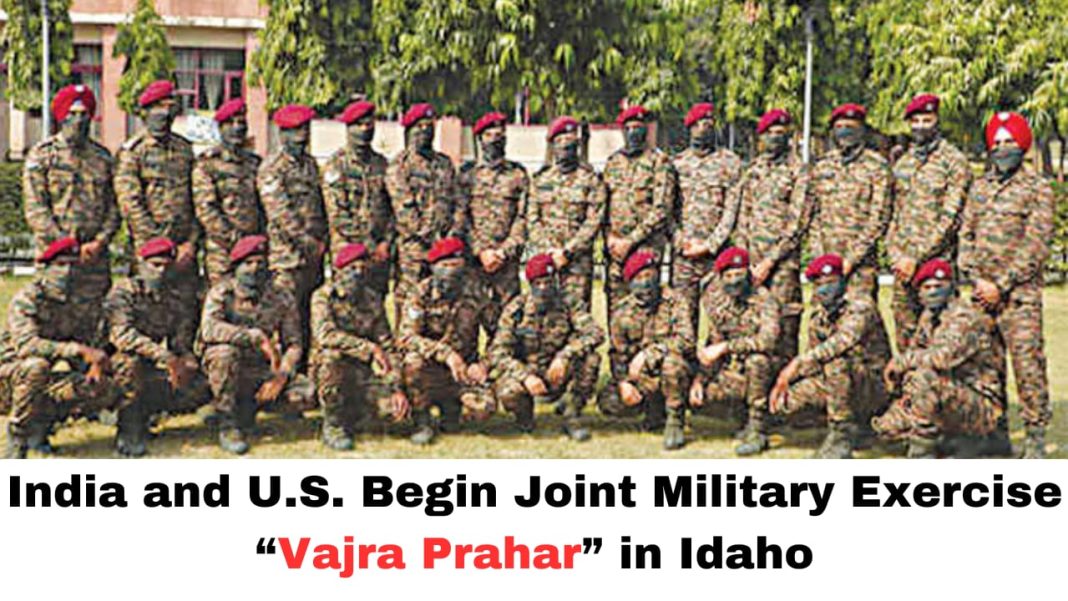Digital News Desk:
India and the United States have launched a joint military exercise, Vajra Prahar, in Idaho, showcasing their commitment to strengthening defense and tactical cooperation. This annual exercise, focused on enhancing interoperability between the nations’ special forces, emphasizes training in counter-terrorism, high-altitude warfare, hostage rescue, and unconventional tactics. Such exercises are part of the broader strategic partnership between the two countries, aimed at ensuring regional stability and addressing mutual security concerns in the Indo-Pacific region.
Background and Objectives of Vajra Prahar
Vajra Prahar, which translates to “Thunder Strike,” has become an integral part of the growing defense relationship between India and the U.S. Initiated in 2010, it alternates annually between locations in India and the United States, allowing both countries’ special forces to familiarize themselves with each other’s training environments, equipment, and tactical strategies. The exercises include joint planning, reconnaissance, tactical coordination, and drills on various combat situations that range from high-altitude terrains to urban settings.

This year, Idaho’s mountainous terrain provides an ideal setting for high-altitude training, preparing both forces for a variety of combat conditions. The U.S. and India are increasingly focused on operations that address asymmetric threats, including counter-terrorism and irregular warfare, and Vajra Prahar gives each force a chance to refine these skills with a global partner.
Tactical and Strategic Significance of Vajra Prahar
At a tactical level, Vajra Prahar is aimed at bolstering the forces’ agility and effectiveness in rapid-response scenarios. Special forces from both nations engage in simulated missions that encompass ambush scenarios, counter-infiltration operations, and the neutralization of high-value targets. Joint operations like Vajra Prahar also emphasize teamwork in complex rescue operations, such as hostage extraction and emergency medical support in combat settings.
Strategically, Vajra Prahar is a signal of commitment to security in the Indo-Pacific, a region increasingly marked by geopolitical competition. As both India and the U.S. seek to counterbalance regional security threats, such as piracy and territorial disputes, exercises like Vajra Prahar strengthen both nations’ rapid-deployment capabilities and their coordination in joint operations. By refining standard operating procedures and communication protocols, these exercises ensure that Indian and American special forces can act cohesively in response to emergencies, regardless of geographic location.

Strengthening the Indo-U.S. Defense Partnership
The Vajra Prahar exercises are part of a broader Indo-U.S. military partnership, which has expanded significantly over the past two decades. India and the United States signed the foundational Logistics Exchange Memorandum of Agreement (LEMOA) in 2016, allowing the two countries to share military bases and logistical support. This agreement, followed by the Communications Compatibility and Security Agreement (COMCASA) and the Basic Exchange and Cooperation Agreement (BECA), has cemented defense ties and facilitated joint exercises like Vajra Prahar and Yudh Abhyas, an annual army-to-army exercise between the two countries.
The broader partnership also reflects India’s growing role as a regional security provider and its importance to U.S. strategic interests in the Indo-Pacific. As the two countries share concerns over security dynamics in South Asia and the rise of China’s influence, military cooperation like Vajra Prahar enables a rapid response framework that can address potential challenges in the region.
Focus on Emerging Security Challenges
Beyond traditional combat training, Vajra Prahar addresses emerging threats that both nations consider significant in today’s security landscape. This includes cyber warfare, electronic intelligence gathering, and the use of unmanned systems in combat. Training in the U.S. also allows Indian forces to gain exposure to cutting-edge technology and operational techniques, which they can integrate into their own systems.
The focus on counter-terrorism and unconventional warfare reflects the shifting priorities of both countries. In recent years, India has faced challenges in border security and terrorism, while the U.S. has been focusing on enhancing its counter-insurgency capabilities. By training in these areas, both nations gain practical insights and techniques from each other’s experiences, especially in counter-terrorism tactics that each side has developed over decades of combat.
Regional Impact and Future Prospects
India and the United States see Vajra Prahar as more than just a military drill—it is also a testament to their shared security objectives and their commitment to upholding peace in an increasingly complex global environment. The exercise underscores both nations’ interests in promoting a free, open, and stable Indo-Pacific region. Given recent global security dynamics, including territorial assertions and economic competition in Asia, a strong Indo-U.S. defense partnership is critical.

The joint exercises also underscore a commitment to long-term security cooperation. As threats evolve and the geopolitical landscape shifts, both India and the United States recognize the importance of ongoing engagement and skill-sharing. Future editions of Vajra Prahar are likely to incorporate even more specialized training, including cybersecurity and artificial intelligence for defense, given these domains’ growing relevance in modern warfare.
Conclusion
Vajra Prahar 2024 reflects the deepening defense partnership between India and the U.S. in a world where military cooperation is crucial for addressing global security challenges. By sharing tactical knowledge, refining rapid-response strategies, and aligning operational frameworks, both nations stand better prepared to face emerging security concerns, both regionally and globally.
As both India and the United States continue to enhance their strategic alignment, joint exercises like Vajra Prahar serve as pillars of mutual strength, ensuring they can respond effectively to future crises. The exercise not only sharpens the readiness of their special forces but also symbolizes the strength of their alliance and shared commitment to global stability.
You May Also Read: BJP Raises Questions on Hemant Soren’s Age in Affidavit, Jharkhand CM Hemant Soren’s Aged 7 years in 5 years ?








